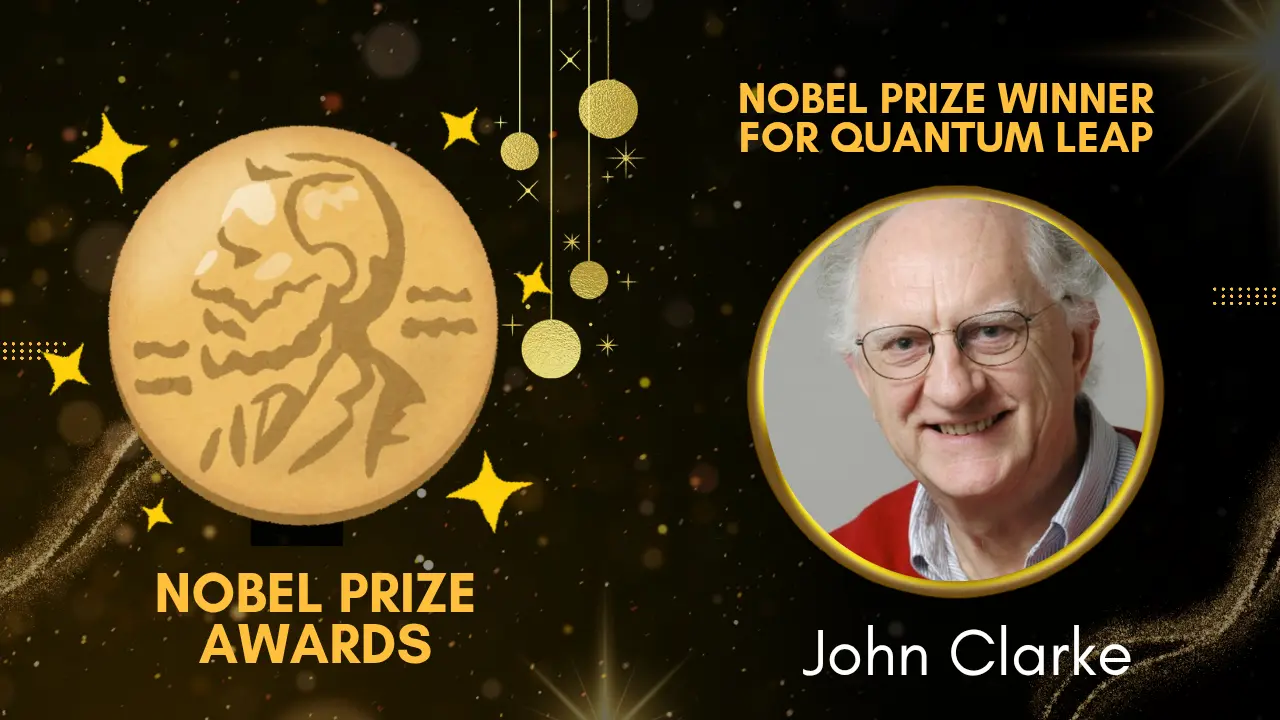John Clarke Nobel Prize 2025: The world of quantum physics often feels like a secret garden, a place where the ordinary rules of reality don’t apply, reserved only for the smallest subatomic particles. But what if we told you that quantum weirdness could be observed and controlled in an object large enough to hold in your hand? This is the monumental breakthrough that earned physicist John Clarke a Nobel Prize in Physics, a discovery that has fundamentally changed our understanding of the universe and is now the bedrock of the future quantum revolution.
The 2025 Nobel Prize in Physics recognized John Clarke, along with his colleagues Michel H. Devoret and John M. Martinis, for their pioneering work: “for the discovery of macroscopic quantum mechanical tunneling and energy quantisation in an electric circuit.” This incredible achievement didn’t just push the boundaries of science; it brought quantum mechanics out of the microscope and into the realm of engineered devices. If you’ve ever wondered what makes quantum computing possible, the answer starts here, with the brilliant mind of John Clarke.
Who is John Clarke? A Pioneer in Superconductivity
Born in 1942, John Clarke is a British-born physicist and Professor Emeritus at the University of California, Berkeley. His career has been dedicated to exploring the esoteric and immensely practical world of superconductivity and ultra-sensitive measurement devices. His work has consistently focused on translating complex quantum phenomena into measurable, useful technology.
The Foundation: Superconducting Quantum Interference Devices (SQUIDs)
To truly appreciate his Nobel-winning work, you must first understand SQUIDs (Superconducting Quantum Interference Devices). Clarke is renowned globally for his development and refinement of these ultrasensitive magnetic flux detectors.
- What they are: SQUIDs are incredibly sensitive magnetometers used to measure extremely subtle magnetic fields. They are so sensitive they can detect a magnetic field a billion times smaller than the Earth’s.
- Why they matter: Clarke’s SQUID research laid the essential groundwork, providing the low-noise, high-frequency instruments that were necessary to perform the delicate quantum tunneling experiments that would eventually win him the Nobel Prize.
The Nobel-Winning Discovery: Macroscopic Quantum Tunneling
The core of John Clarke’s Nobel Prize is the revolutionary demonstration of quantum effects on a macroscopic scale. For decades, the dominant view was that quantum mechanics only applied to tiny particles. Once a system got “too big”—involving billions of particles—the peculiar quantum effects were expected to vanish, drowned out by classical physics. Clarke, Devoret, and Martinis proved this assumption wrong.
The Phenomenon: Quantum Tunneling
Quantum tunneling is one of the strangest and most counter-intuitive concepts in physics.
- Classical Expectation: Imagine a marble rolling toward a hill. If it doesn’t have enough energy to roll over the hill, it stops and rolls back. This is classical physics.
- Quantum Reality: Quantum mechanics dictates that a particle has a tiny, non-zero probability of simply tunneling straight through the hill, even if it lacks the energy to go over.
The Experiment
Working at UC Berkeley in the mid-1980s, the team built a specially designed electrical circuit using superconductors separated by a thin insulating layer—a structure known as a Josephson junction.
- They cooled the circuit to near absolute zero to eliminate thermal noise.
- They monitored the current flow across the junction.
In their groundbreaking experiments, they showed that the collective movement of billions of charged particles (Cooper pairs) in the superconductor behaved as a single, unified “macroscopic particle.” This single entity was observed to exhibit:
- Macroscopic Quantum Tunneling (MQT): The current spontaneously switched between a zero-voltage state and a finite-voltage state—tunnelling through the energy barrier, a clear quantum effect in a circuit large enough to be seen with the naked eye.
- Energy Quantization: They also confirmed that the circuit’s energy levels were quantized—meaning the energy could only exist at specific, discrete values, like steps on a ladder, rather than a continuous ramp.
Quote: When notified of his Nobel win, Professor Clarke remarked, “To put it mildly, it was the surprise of my life.” This humility highlights the nature of pure scientific pursuit, where the possibility of a Nobel is often secondary to the excitement of discovery itself.
The Legacy of John Clarke’s Nobel Work: Quantum Technology
The work that secured John Clarke a Nobel Prize is far more than an academic curiosity; it is the fundamental building block of the second great quantum revolution.
1. Quantum Computing
The circuits designed by the Nobel laureates were the direct forerunners of the superconducting qubits that form the heart of many modern quantum computers.
- Qubit Foundation: To be a qubit, a device must be able to exist in a quantum superposition of two states simultaneously (the “0” and “1” of quantum computing).
- Clarke’s Link: By proving that a macroscopic circuit could have quantized energy levels and exhibit tunneling, they demonstrated that these engineered systems could indeed be controlled to behave like quantum objects, making the dream of a large-scale, fault-tolerant quantum computer a tangible goal.
2. Ultra-Sensitive Sensors
Beyond computing, the principles validated by Clarke’s team are enhancing ultra-sensitive detectors for a variety of applications.
- Geophysics: Improving the accuracy of magnetotellurics (a geophysical survey technique).
- Biomedical Imaging: Enabling new, ultra-low-frequency Nuclear Magnetic Resonance (NMR) and Magnetic Resonance Imaging (MRI) schemes.
- Fundamental Physics: SQUID amplifiers, born from Clarke’s earlier research, are now being used in the search for the axion, a leading candidate for dark matter.
Statistic: As of the prize announcement, the trio’s discovery has directly influenced the development of superconducting qubits, which make up over 50% of the quantum computing architectures currently being explored by major tech companies worldwide. This shows the immediate and profound impact of the work that led to John Clarke’s Nobel Prize.
Looking Ahead: The Future is Quantum
The life and work of John Clarke serve as a powerful reminder that the biggest breakthroughs often come from asking the most fundamental questions. By proving that the weird laws of the quantum world don’t disappear just because a system is large, Clarke and his colleagues opened a new era of technology. The full potential of quantum computing—from designing new drugs to revolutionizing materials science—rests firmly on the foundation laid by this Nobel-winning research.
FAQs About John Clarke’s Nobel Prize
Q1: What exactly did John Clarke win the Nobel Prize for?
John Clarke, along with Michel H. Devoret and John M. Martinis, won the 2025 Nobel Prize in Physics for the “discovery of macroscopic quantum mechanical tunneling and energy quantisation in an electric circuit.” This work proved that quantum effects, previously thought to be limited to microscopic particles, can be reliably observed and controlled in an engineered electrical circuit.
Q2: What is “Macroscopic Quantum Tunneling” in simple terms?
In simple terms, it’s the quantum phenomenon of an object passing through an energy barrier instead of having to go over it, but demonstrated on a “large” scale—a circuit chip you could see with your eye. It means that the entire circuit, made of billions of electrons, behaves like a single quantum particle.
Q3: How is this research related to quantum computing?
This research is the direct foundation of quantum computing. The quantum circuit they studied, specifically the Josephson junction, serves as the precursor to the superconducting qubit. Their work demonstrated the essential quantum mechanical behavior—superposition and discrete energy levels—that allows a qubit to store and process quantum information.
Q4: Which university is John Clarke affiliated with?
John Clarke is a Professor Emeritus of Physics at the University of California, Berkeley. His Nobel Prize-winning experiments were largely conducted while he was leading research at UC Berkeley.
Q5: Did John Clarke work on SQUIDs, and is that related to the Nobel Prize?
Yes, John Clarke is a leading expert on SQUIDs (Superconducting Quantum Interference Devices). While his Nobel was for the macroscopic quantum tunneling discovery, his extensive work on developing SQUIDs was crucial. The SQUIDs provided the ultra-sensitive instrumentation needed to perform the incredibly delicate and precise measurements of the quantum effects in the experiment.

















